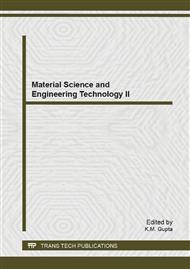[1]
DiGenova KJ, Botros BB, Brisson JG. Method for customizing an organic Rankine cycle to a complex heat source for efficient energy conversion, demonstrated on a Fischer Tropsch plant. Applied Energy 2013; 102: 746-754.
DOI: 10.1016/j.apenergy.2012.08.029
Google Scholar
[2]
Algieri A, Morrone P. Comparative energetic analysis of high-temperature subcritical and transcritical Organic Rankine Cycle (ORC). A biomass application in the Sibari district. Applied Thermal Engineering 2012; 36: 236-244.
DOI: 10.1016/j.applthermaleng.2011.12.021
Google Scholar
[3]
Sharaf MA, Nafey AS, Lourdes GR. Thermo-economic analysis of solar thermal power cycles assisted MED-VC (multi effect distillation-vapor compression) desalination processes. Energy 2011; 36(5): 2753-2764.
DOI: 10.1016/j.energy.2011.02.015
Google Scholar
[4]
Tchanche BF, Lambrinos G, Frangoudakis A, Papadakis G. Low-grade heat conversion into power using organic Rankine cycles-A review of various applications. Renewable and Sustainable Energy Reviews 2011; 15(8): 3963–3979.
DOI: 10.1016/j.rser.2011.07.024
Google Scholar
[5]
Soroureddin A, Mehr AS, Mahmoudi SMS, Yari M. Thermodynamic analysis of employing ejector and organic rankine cycle for GT-MHR waste heat utilization: Acomparative study. Energy Conversion and Management 2013; 67: 125-137.
DOI: 10.1016/j.enconman.2012.11.015
Google Scholar
[6]
Mago PJ, Luck R. Evaluation of the potential use of a combined micro-turbine organic Rankine cycle for different geographic locations. Applied Energy 2013; 102: 1324-1333.
DOI: 10.1016/j.apenergy.2012.07.002
Google Scholar
[7]
Sprouse III C, Depcik C. Review of organic Rankine cycles for internal combustion engine exhaust waste heat recovery. Applied Thermal Engineering 2013; 51: 711-722.
DOI: 10.1016/j.applthermaleng.2012.10.017
Google Scholar
[8]
Yu GP, Shu GQ, Tian H, Wei HQ, Liu L. Simulation and thermodynamic analysis of a bottoming Organic Rankine Cycle (ORC) of diesel engine (DE). Energy 2013; 51: 281-290.
DOI: 10.1016/j.energy.2012.10.054
Google Scholar
[9]
Katsanos CO, Hountalas DT, Pariotis EG. Thermodynamic analysis of a Rankine cycle applied on a diesel truck engine using steam and organic medium. Energy Conversion and Management 2012; 60: 68-76.
DOI: 10.1016/j.enconman.2011.12.026
Google Scholar
[10]
Srinivasan KK, Mago PJ, Krishnan SR. Analysis of exhaust waste heat recovery from a dual fuel low temperature combustion engine using an Organic Rankine Cycle. Energy 2010; 35: 2387-2399.
DOI: 10.1016/j.energy.2010.02.018
Google Scholar
[11]
Macián V, Serrano JR, Dolz V, Sánchez J. Methodology to design a bottoming Rankine cycle, as a waste energy recovering system in vehicles. Study in a HDD engine. Applied Energy 2013; 104: 758-771.
DOI: 10.1016/j.apenergy.2012.11.075
Google Scholar
[12]
Wang EH, Zhang HG, Zhao Y, Fan BY, Wu YT, Mu QH. Performance analysis of a novel system combining a dual loop organic Rankine cycle (ORC) with a gasoline engine. Energy 2012; 43: 385-395.
DOI: 10.1016/j.energy.2012.04.006
Google Scholar


